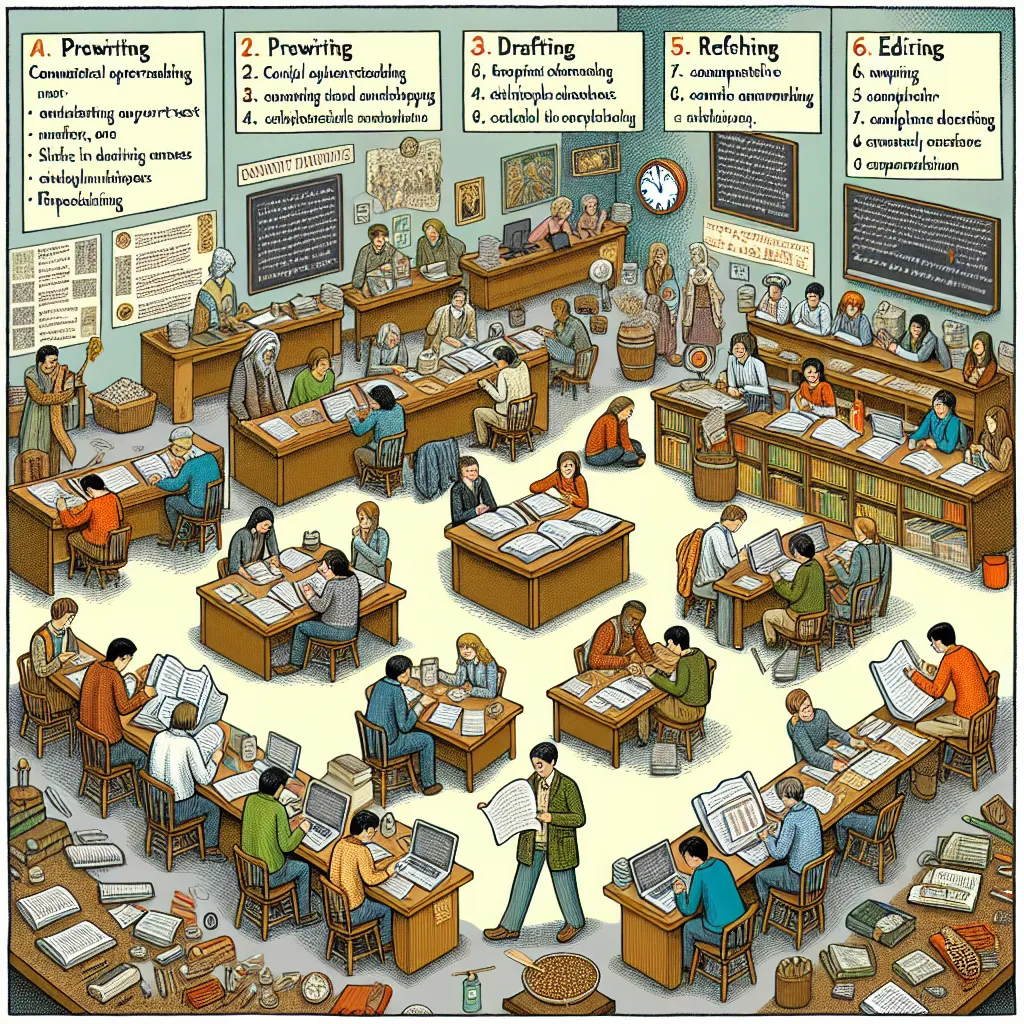Ask AI on The Internet
Question: Write a 4 pages essay detailing your approach to teaching a narrative essay using the writing process. In your essay, describe activities that you would give to the learners to go through the process of writing.
Title: Teaching Narrative Essay Writing: A Strategic Approach Using the Writing Process Abstract: Teaching narrative essay writing effectively requires a structured approach that guides students through the different stages of the writing process. This approach not only helps students improve their writing skills but also instills confidence and creativity in their storytelling abilities. This essay endeavors to detail a comprehensive strategy to teach narrative essay writing, outlining specific activities that students can engage in at each stage of the writing process: prewriting, drafting, revising, editing, and publishing. Introduction: The narrative essay is a powerful tool that invites students to delve into their creative reservoirs, recount personal experiences, and tell compelling stories. Mastering the narrative essay involves understanding the nuances of storytelling, character development, and descriptive language. By utilizing the writing process—prewriting, drafting, revising, editing, and publishing—teachers can provide an organized framework that systematically develops students' narrative writing skills. I. Prewriting: The Foundation of Narrative Writing The prewriting stage sets the groundwork for the narrative essay. During this phase, students brainstorm ideas, organize thoughts, and plan their stories. A. Brainstorming Activities: 1. **Freewriting:** Encourage students to spend 10 minutes writing continuously about a personal experience or a memorable event without worrying about grammar or structure. This freewriting exercise helps students generate raw content and ideas. 2. **Mind Mapping:** Have students create a visual representation of their story ideas using a mind map. Centralize the main event or theme and branch out to include characters, settings, emotions, and key plot points. B. Story Structure and Planning: 1. **Plot Diagram:** Introduce students to the classic narrative structure—exposition, rising action, climax, falling action, and resolution. Ask them to plot their story on a diagram to visualize the flow of their narrative. 2. **Character Profiles:** Provide worksheets for students to develop detailed profiles for their main characters, focusing on traits, backgrounds, motivations, and relationships. II. Drafting: Bringing Ideas to Life The drafting stage is where students begin to transform their ideas into a coherent narrative. This phase emphasizes getting the story down on paper without worrying too much about perfection. A. Setting the Scene: 1. **Sensory Descriptions:** Conduct an activity where students describe a setting using all five senses. This exercise sharpens their ability to create vivid, immersive environments in their narratives. 2. **Opening Hooks:** Teach students different techniques for writing captivating opening sentences. Have them write several opening lines and share them with the class for feedback. B. Building the Story: 1. **Dialogue Practice:** Organize a workshop on writing realistic and engaging dialogue. Use role-playing activities where students act out a conversation between characters. 2. **Pacing and Transition:** Discuss the importance of pacing in a narrative. Have students write a scene and then rewrite it, focusing on altering the pacing and using smooth transitions between paragraphs. III. Revising: Refining the Narrative Revising is a critical stage where students enhance the clarity, coherence, and overall quality of their narrative essays. A. Peer Review: 1. **Peer Feedback Sessions:** Pair students and have them exchange drafts. Provide a guided checklist focusing on narrative elements such as character development, plot consistency, and descriptive language. Encourage constructive feedback. 2. **Group Workshops:** Create small groups where students read their stories aloud. Group members offer suggestions for improvement, focusing on narrative flow and emotional impact. B. Self-Revision: 1. **Revision Checklists:** Supply students with checklists that prompt them to consider aspects such as coherence, detail, and narrative voice. Have them use the checklist to revise their own work. 2. **Highlight Exercise:** Ask students to highlight different elements of their story (e.g., green for descriptive detail, blue for dialogue) to ensure a balanced and engaging narrative. IV. Editing: Polishing the Final Product The editing phase focuses on fine-tuning the mechanics of writing, such as grammar, punctuation, and spelling. A. Editing Drills: 1. **Grammar Workshops:** Conduct targeted workshops on common grammatical errors observed in students' drafts. Provide exercises for practice and improvement. 2. **Proofreading Partners:** Pair students for final proofreading sessions where they focus on correcting each other's spelling, punctuation, and syntax. Use a checklist to guide the proofreading process. B. Use of Technology: 1. **Editing Tools:** Introduce students to online tools and software (such as Grammarly or Hemingway) that can aid in identifying and correcting errors. Teach them how to use these tools effectively. 2. **Visual Editing:** Encourage students to print their drafts and annotate them manually with editing marks. This tactile approach can help in identifying errors more clearly. V. Publishing: Sharing the Narrative The publishing stage culminates the writing process, giving students a sense of accomplishment as they share their polished narratives with an audience. A. Class Anthologies: 1. **Create a Book:** Compile students' narrative essays into a class anthology. This can be produced digitally or in print, providing a tangible product of their hard work. 2. **Presentation Day:** Organize a class event where students read their stories aloud to peers, parents, and teachers. This public sharing fosters a sense of pride and achievement. B. Digital Platforms: 1. **Blogging:** Set up a class blog where students can publish their narrative essays. This exposes them to a wider audience and the concept of online publication. 2. **Digital Storytelling Tools:** Introduce multimedia storytelling tools (such as Storybird or Adobe Spark) that allow students to create digital stories incorporating text, images, and audio. Conclusion: Teaching narrative essay writing through the writing process provides a structured yet flexible approach that addresses all aspects of storytelling. By engaging students in prewriting, drafting, revising, editing, and publishing activities, teachers can cultivate not only technical writing skills but also creativity, critical thinking, and self-expression. This comprehensive strategy ensures that students are well-equipped to craft captivating and meaningful narratives, enhancing their overall writing proficiency and confidence.
Think your answer is better than the AI's? Post it below.
Other Most Relevant Posts:
 Ask AI: Justify your understanding of how children employ narrative skills. Provide concrete
examples to support your answer.
Ask AI: Justify your understanding of how children employ narrative skills. Provide concrete
examples to support your answer.
 Ask AI: justify your understanding of how children employ narrative skills. provide concrete examples to support your answer
Ask AI: justify your understanding of how children employ narrative skills. provide concrete examples to support your answer
Question Tags
If you want your question answered by an AI, click here.





Post your own comment: